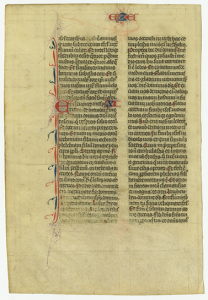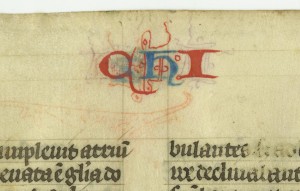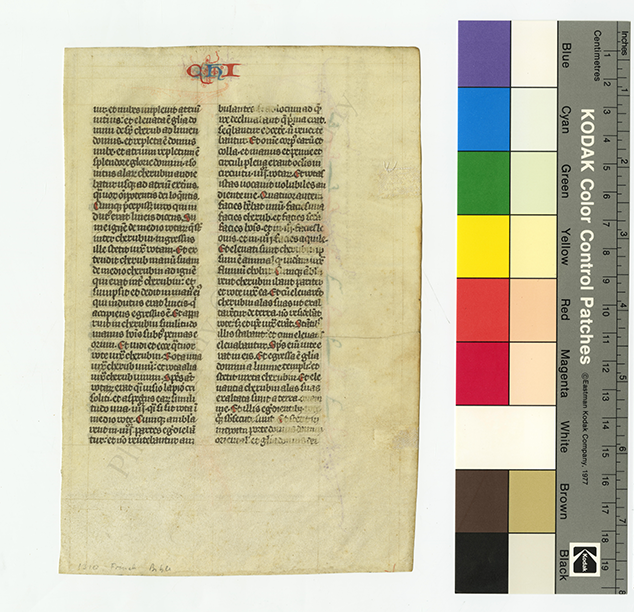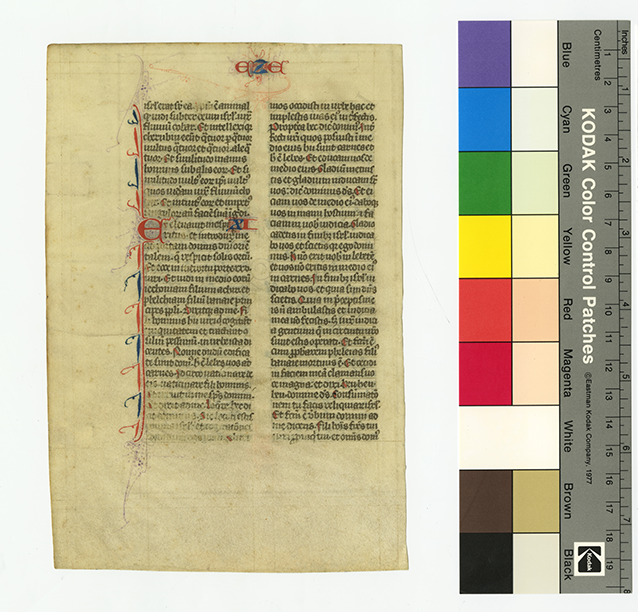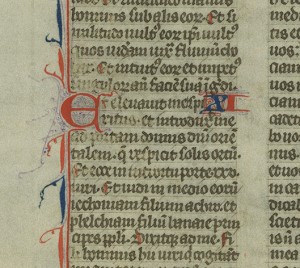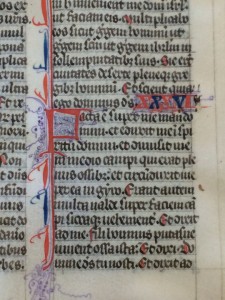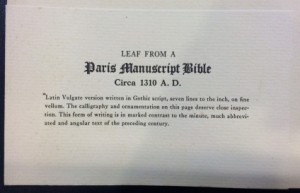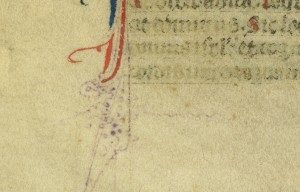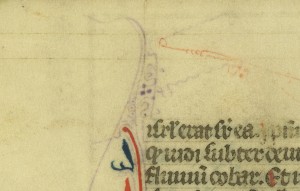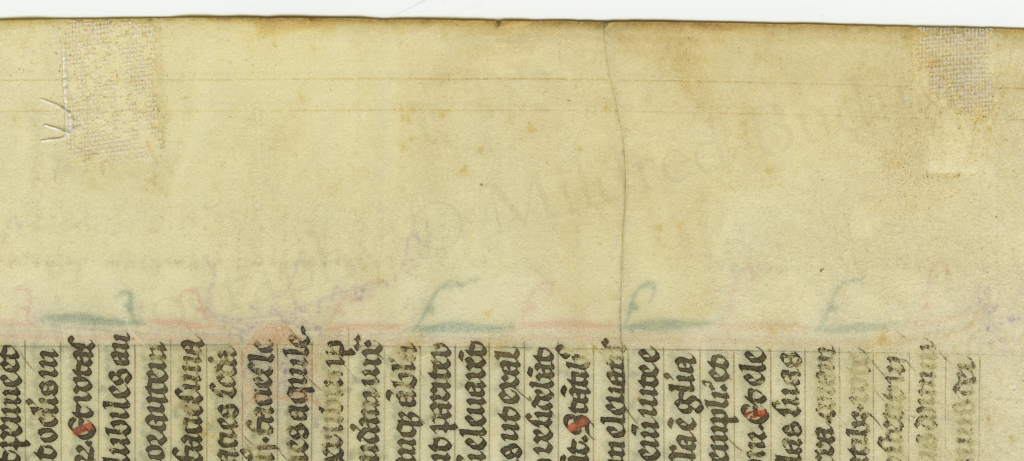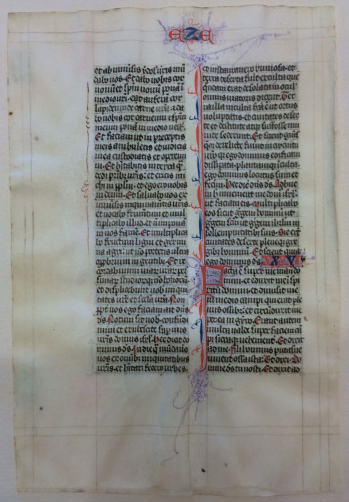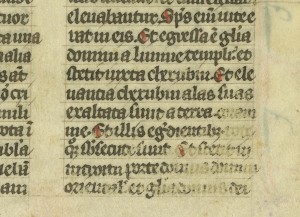A New Leaf from ‘Otto Ege Manuscript 61’
August 10, 2015 in Manuscript Studies, Photographic Exhibition
Part of Ezekiel from a
32-Line Latin Vulgate Pocket Bible from France
Budny Handlist 7
Single leaf from a pocket-sized Bible
Circa 186 × 126 mm <written area circa 119 × 81 mm>
Double columns of 32 lines in Gothic Bookhand, with embellishments in red, blue, and purple pigment
Pencil inscription ‘1310 French Bible’ at the bottom of the recto
Formerly part of Ege Manuscript 61 (Gwara, Handlist 61)
Southern France, circa 1325
[Posted on 10 August 2015, with updates. The updates include, with permission, images from the leaf also in Exekiel from the same manuscript in Ege’s Portfolio, now at the University of Pennsylvania, and shown in a post on Penn Libraries Manuscripts, with photographs by Dot Porter. The photographs of the New Leaf are © Mildred Budny.
More recently, the announcement that (after earlier sales from that collection), the residue of manuscript materials in the possession of Otto F. Ege’s family has been purchased by the Beinecke Library at Yale University encourages the anticipation of more revelations about surviving leaves from the dispersed manuscripts, perhaps also this one.]
Sums It Up
Continuing our series on ‘Manuscript Fragments’, we focus on another leaf dispersed through the efforts of Otto F. Ege (1888–1951) in assembling and distributing Portfolios of specimen leaves extracted from original one-of-a-kind manuscript books. Previously we considered the issues of Ege’s Lost and Foundlings, and then reported the discoveries of a New Leaf from Ege Manuscript 41 and from Ege Manuscript 8. [Followed by the report of a New Leaf from Ege Manuscript 14.] Different sizes, different texts, same predicament.
Set ‘free’ from their original manuscript homes (Boo Hoo!), they have had to roam on their own. Cut out and cast out.
Pocket-Sized Book, Ready to Roam
Now we turn to one of Ege’s Bible manuscripts. The Bible in various forms and languages, including full Christian Bibles with both Old and New Testaments, was one of his specialties. That is clear from the number of them that he assembled, dis-assembled, and re-distributed, in bits and pieces.
This time, the New Leaf from the Book of Ezekiel in the Latin Vulgate Version formerly belonged to a small-format Bible in a genre which emerged in the widespread production of ‘pocket Bibles’ in the 13th century. The ‘miniaturization’ of Bible manuscripts in Western Europe during this period represents a fascinating development for the book production of an essential text of considerable length for people on the move. Preachers, scholars, readers included. Ready to roam, remember?
There are many specialized studies about the genre. An illustrated guide to its development and some of its variations can be found in a chapter on 13th-century Portable Bibles. To keep it slim (as if!), you can find, for example, a precise, dedicated study about what their sizes and lines per-page — anyway considering the survivors — could mean for understanding their significant transmission patterns, according to the evidence (taking a sample of 357 Bibles personally seen, out of more than 1,500 survivors).
The majority originated from France, although other regions contributed to the total. Most portable Bibles were produced in Paris, Southern England, and Northern Italy. Production was intense, and standardized to various extents, which could increase output. The rush was on. Everybody or Anybody needed such a book.
Sizing It Up
In this case, the book size (overall dimensions — that is, height plus width — of 312 mm), the number of lines per page (32), the written area (circa 120 × 81 mm in double columns), and the ‘unit of ruling’ for the average height of a line area (circa 3,40 mm) fall variably within the main standards of measurements tabulated for the genre. Almost all cases have double columns (although a very few, as in less than a dozen surveyed, have single columns). Most have larger sizes (up to 450 mm overall dimensions), more lines per page (into the 50s!), a larger written area, and a smaller unit of ruling (an average of 2.64 mm).
So, all variants considered, this specific dispersed manuscript seems to be a rather unusual book even among its surviving peers. Such factors may point to a rather early phase or a rather late phase in the development, to an out-of-the-way place of production, outside the mainstream, or to a specific set of choices which represent an approach that could at the time have had wider representation than the recognized survivors demonstrate. Or a combination thereof.
The proposed assignment currently of ‘Southern France, circa 1325’ as the region and date-range for the production of Ege Manuscript 61, to which this leaf belonged, seems to fit with such criteria. Of course, that assignment has the benefit of more information about the original manuscript than this single leaf alone might contain.
Easy Pick Up and Go
Designed for portability, these compact ‘pocket’ books could cover the complete text of the Bible in very small format through the use of especially thin and lightweight leaves, as well as tiny script which compacts a maximum amount of text onto the page. Some copies, moreover, packed glosses, or comments and explanations, into the margins, but this New Leaf remains ‘clean’ with clear space around the columns of the Bible text, apart from the running titles which orient the reader through its different Books.
Maybe glosses or comments were intended, to be entered, whether in the original production or as part of the processes of use. Anyway, here it didn’t happen.
Pristine and untouched. Er, apart from the signs of wear on several parts of the leaf, recto and verso, where parts of the original text have rubbed or faded away.
Sometimes the packing of text-to-page in a Pocket Bible required dividing the small, but thick, book into more than one handy volume. Here, too, apparently, these divisions may have pertained. (Spoiler Alert.)
Meanwhile, let’s see what we can see when we look at the leaf itself.
Taking it EZE
With this New Leaf, simply looking it, already at first glance, we can recognize its text directly as part of EZE/CHI[EL]. That is, from the Book of Ezekiel, in the Latin Vulgate version, as customary for the genre of Pocket Bibles in the 13th century and beyond.
EZE-PEAZY. (Heh, heh.) Especially so when I show you the parts in the correct textual order, only not how they appear on the leaf itself, left to its own devices.
If we were stuck with this Leaf Alone, Roam Alone, we would have to step back from the leaf itself (recto and verso) to re-imagine the former book to which it belonged. In that case, we need to read it Back to Front.
Happily, we can have it both ways. I offer the views of both parts of the title, stretched or spaced across the pages, to show how they logically should read.
You see, the spacing of the running title in halves respectively on the recto and verso of the individual leaf presupposes the full title to be visible across an opening of the little book, with EZE on the verso of the preceding leaf and CHI on this one, and the inverse on the next opening. Thus the running titles would form neatly matching pairs between consecutive leaves, in a continuing chain of command which employs three letters apiece for its series of linked messages, and which leaves the completion of the name of the Book and its Prophet up to the reader. Who would be Us.
Both Sides of the Picture
Now for the leaf as a whole.
This lovely little leaf places its whitish flesh side of the animal skin on the recto, and the yellowed hair side on the verso. Double columns (‘a’ and ‘b’) on each page contain 32 lines of script. In terms of the modern system of Bible chapters-and-verse, the text begins within Ezekiel 10:3 ([ingrederetur presumably on the previous page] / uir et nubes impleuit), completes that Chapter in column a on the verso, opens the next chapter straightaway, and breaks off within 11:15 (et omnis domus / [israhel presumably on the next page]).
The Bible text is packed into the lines of text as far as the column allows, and then some, with bits of overspread, sort of like the overspread sides of a muffin top, here and there. That is, the text is made to conform with right- as well as left-justification. Sort of.
What we ourselves think about right-justification, anyway as it appears in print, is stated in our Style Manifesto. That explains why our website does not use that feature, by design. Here, however, on the New Leaf, it’s fine. Hey, it’s a manuscript!
Besides, its right-justification does not produce rigid vertical edges or odd rivers of blank spaces as in many printed texts. The compacted text, including many abbreviations, aims to cover as much text as possible without sacrificing legibility. The double columns likewise allow for increased density of text on a single page without comprising its legibility. Form and function co-ordinate here, as is appropriate for good book-design.
Colorized
Some elements are polychrome, as a contrast with the standard brown ink of the main text. Already mentioned are the emphatic running titles, with their bubbly flourishes. Their letters alternate between red and blue pigment, the blue letters in their center have pen-flourishes in red to form decorative frames and extend upward and downward in undulating loops and curls. To the lower left of EZE extends a separate pen-flourish in red forming a descending curve into a long rising diagonal tail over column a, with expanded extensions from the downward curve into the upper part of the intercolumn. Graceful and fanciful. Clearly professional and proficient.
The opening for Ezekiel Chapter XI offers a 2-line indented initial E in red pigment (lines v12–13), embellished with frilly infill and extensions of elaborate purple penwork. The chapter number XI squeezes into the truncated first line of the Chapter text, evidently indented to contain it.
That prominent numeral resembles the polychrome form and decoration of the running title, similarly with red penwork for the filling of its blue element (X). Within the text, the different sections follow the previous sections in continuous lines of script. Their opening letters have a wash of red pigment, as a helpful finding aid.
The left-hand edge of the column has a vertical frame of interlocking J-bars which alternate between blue and red pigment. There are 4 J-bars above the initial and 7 below. These sets stand outside a pair of vertical red lines with hooked tips which curve outward from above and below the Chapter initial, run more-or-less vertically alongside the column, and curve outward opposite the top and bottom of the column. Segments of purple penwork extend from the cusp between those hooks and the column to reach far into the upper and lower margins, as well as, at the top, into the inner margin.
With their more-or-less vertical stems toward the column, the J-bars turn their feet or heads outward, either as feet above the initial or as heads below it. This alignment forms a clear bracketed distinction between the two chapters which respectively come to an end and commence in this column.
Numbered
As characteristic for many 13th-century portable Bibles, this case adopts the standard version of chapter numbers familiar to us in modern Bibles. (The adoption of the verses as we know them occurred later, only by the early modern period.) This system evolved by the early 13th century, apparently in Paris in the first quarter of the century, in response to the proliferation of scholastic commentaries in the 12th century and the continuing need to locate specific passages precisely and consistently.
Earlier systems of numeration, such as the lists of Capitula (‘Chapters’) in Bibles of the earlier Middle Ages, had their functions and adherents, but their divisions were variable, according to various forms, sometimes applied inconsistently within a single manuscript, and moreover erratic in their transmission between manuscripts. They proved to be too cumbersome and unreliable as intensive study of the Bible continued its focus.
The new system — sometimes attributed to Stephen Langton, who became Archbishop of Canterbury (1207–1228) after lecturing at Paris — apparently became a standard feature in pocket Bibles by circa 1240. The New Leaf belongs to these New Numbers.
Its highlighted sections within the Bible Chapters correspond in part to the modern verses, but that next system of standardized divisions belongs to another phase in the long history of the transmission and study of the Bible, in Latin and other languages, across the centuries, in manuscript and print. On the New Leaf, the series of sections are still unnumbered. But they do employ some forms of distinction, for example, in their ‘Capital’ opening letters and the red wash within them.
Ege-Headed
Otto Ege’s printed caption for Specimen Number 4 in his Portfolio — I quote from its version in Series II at Princeton University — proclaims it to be
LEAF FROM A
Paris Manuscript Bible
Circa 1310 A.D.
Latin Vulgate Version written in Gothic script, seven lines to the inch, on fine vellum. The calligraphy and ornamentation on this page deserve close inspection. This form of writing is in marked contrast to the minute, much abbreviated and angular text of the following century.
A shaded reproduction of this caption on a slip of paper accompanies the publication of another leaf from the Book of Ezekiel at the University of Pennsylvania.
Otto Ege’s attribution of the manuscript, or leaves therefrom, as a ‘1310 French Bible’ can similarly be seen in his pencil inscription at the lower front of the New Leaf. Traces of his characteristic gauze-like adhesive mounting tapes moreover can be seen on the outer edges of the verso of the leaf, attesting to the former position attached to a mount of some kind, turning the side or page with more decoration (and, supposedly, visual appeal) to the front, like many other characteristic ‘Ege-style’ tapes and mats on his detached leaves prepared for the Portfolios and for the distribution of some of the other leaves now known as ‘Rogue Leaves’, cast to the winds on their own.
Often that arbitrary redistribution had to take place, sad to say, with very little (if any) account of their origins, of other similarly ‘orphaned’ siblings thrust out into the world through the same processes, and of the former contexts which they once had within their original manuscripts and their former collections. Bad, Bad, Bad.
Sometimes — when opportunity is found — it takes dedicated detective work to reconstruct the former manuscript and to identify the leaves which might survive from it, at least in part. Spectacular results are already visible for the Beauvais Missal (‘Otto Ege Manuscript 15″).
A French Pocket Bible Apparently in Two Volumes
Divided Between Psalms and Isaiah
The source manuscript is, at least in part, Gwara Handlist Number 61. Detached leaves from it are distributed individually as Number 4 within two of Ege’s early Portfolios, issued in 2 versions respectively in 1936 and 1938, with different numbers of leaves and different numbers of sets. Other leaves are distributed as ‘Rogue Leaves’ in the form of leaves and/or bifolia which have found their way into various collections, both public and private. Those patterns of distribution are familiar, alas, to scholars of manuscript fragments.
Ege’s arrangements of detached leaves in portfolios exhibiting features of script, decoration, and book design across the centuries are described in an earlier post, with links to more studies and illustrations of those habits.
‘Original Leaves’, Detached & Dispersed
These two Portfolios assembled by Ege share the same title of Original Leaves from Famous Bibles, Nine Centuries 1121–1935 A.D. Issued in 2 series or versions, they are Series A and B, as listed in an inset printed caption in the latter (reproduced in Gwara, Otto Ege’s Manuscripts, Figure 61) or Series I and II, as listed by both John P. Chalmers, ‘Checklist of Leaf Books’, Number 68, and Scott Gwara, Otto Ege’s Manuscripts, Appendix I (pages 95-96). Unlike Ege’s Fifty Original Leaves Portfolio, with numbered sets, the Famous Bibles Portfolios (both versions) are unnumbered. Their specimens include only 4 (Numbers 1-4) from manuscripts, while the rest come from printed Bibles.
The Portfolios appeared in these ways:
I. Series A [or I], with 37 leaves in 200 sets, issued in October 1936
Famous Bibles, I = Chalmers, Checklist, Number 68
Gwara, Appendix I, pages 95–96, lists the locations of 31 sets, including one set ‘now dispersed’.
II. Series B [or II], with 60 leaves in 100 sets, issued in October 1938
Famous Bibles, II = Checklist, Number 73
Gwara, Appendix II, pages 97–99, lists the locations of 51 known sets.
Within both Series, leaves from the source manuscript appear as Number 4. In Scott Gwara’s Handlist of Manuscripts Collected or Sold by Otto F. Ege (2013), the manuscript, with its traceable remnants, is Number 61 (Appendix X, pages 140–141).
The ‘find places’ of the dispersed leaves within these Portfolios establish that the dismemberment had already begun by the time of the preparation of the first Series, that is, at the latest, by 1936 (although cited as ‘1938’ in Gwara, Otto Ege’s Manuscripts, page 346). The dismemberment and dispersal of some Portfolios themselves (as here) might seem like fair play, or anyway turnaround.
The two declared series of 100 + 200 sets with 1 leaf apiece in the Portfolios account for 300 leaves, with many more to spare.
Some other detached single leaves or bifolia (the paired, conjoint leaves from the single, folded sheet of one animal’s skin) have surfaced as ‘Ege Rogue Leaves’ — that is, not issued in any of Ege’s Portfolios but only by other means — including the New Leaf. Some are listed as Gwara Handlist Numbers 61.1–7, belonging to various institutional collections in the United States. Now emerging in private ownership, newly identified as an Ege Lost and Foundling, the New Leaf deserves to be added to their company.
Parts of the Pocket Bible, Prices & Mats Included
According to Otto Ege’s caption for the dual Portfolio series, the original manuscript comprised a ‘Paris Manuscript Bible, ca. 1310 A.D.’ Hence, obviously, the ‘Ege inscription’ in pencil at the bottom of the recto of the New Leaf: ‘1310 French Bible’.
According to the advertised prices (reported in Gwara, Otto Ege’s Manuscripts, page 348), single leaves from this very bible cost US $2.50 for a leaf, and $20.00 for one with a historiated initial, in the 1944 Lima Public Library sales catalogue, and their prices had risen respectively to $3.50 and $25.00 in a sales catalogue of circa 1952 (now at Samford University, Birmingham, Alabama). Unlike some other ‘Rogue Leaves’ from Ege Manuscripts (for example in the Budny Handlist, illustrated here, the ‘Ege inscription’ on the New Leaf does not cite its price.
Like the ‘Ege-matted’ Portfolio leaves and some other ‘Rogue Leaves’ from Ege Manuscripts, this leaf preserves the traces of its ‘Ege-style mount’ in the form of the characteristic gummed gauze tapes. When I first saw the leaf, this was its condition, with the tapes having already been removed (almost), along with their former mat (now lost). Hard to say when that removal, and the discarding of the mat, occurred. Perhaps even before the leaf reached its present owner, at a time unremembered and unrecorded.
The Books of the Bible
Some specimens of Ege Manuscript 61 can be viewed freely online. They include examples from
Portfolio Series I:
- Epistle to Romans 8 – 10:9 at Saint John’s University
Portfolio Series II:
-
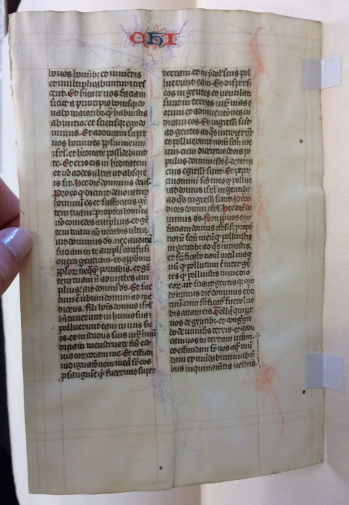
Recto of the Exekiel Leaf in the University of Pennsylvania, plus its mounting tapes. Reproduced by permission
Ezekiel 36:11 ([et reple-/]bo vos hominibus) – 37:4 (dixit ad) [/ [me] at the University of Pennsylvania
- Acts of the Apostles 18:16 (miniauit) – 19:5 (nomine) on recto at the Public Library of Cincinnati and Hamilton County
- Romans 1:27 [desideri]is suis in inuicem – 3:4 sermoni[bus] at Furman University
- Apocalypse 9:17 (erant) – 11:13 (septem) at Ball State University
Online information (but not viewing) and personal consultation respectively reveal the contents of two other examples in this same Series II:
- Jeremiah 29–30 at Ave Maria University
- I Maccabees 14:30 (congregauit) – 15:13 (cum centum) at Princeton University
Worth recording that the Portfolio Series II at Kent State University does not contain a leaf from this Bible.
Some ‘Rogue Leaves’, like the New Leaf, belong to the Old Testament:
- I Chronicles 10:13 ([prevari-/]catus)– 13:14 at Oberlin College = Gwara Handlist 61.6
- Isaiah 44:6 (exercitum) – 45:6 (non est deus) = for sale in Enchiridion 21: Medieval Fragments for Teaching & Research, Number 2j.
- Jeremiah 33:14 – 34:3 (et oculi) at the Providence Public Library = Gwara Handlist 61.7
- Ezekiel 10:3 (uir) – 11:15 (domus) = Budny Handlist 7, or, the ‘New Leaf’ (You are Here)
A fuller examination of the leaves overall, as they emerge, would or could establish the patterns of distribution of portions extracted from which Books into which directions allocated among the Portfolio editions and the ‘Rogue’ components. But more important than deciphering the patterns of distribution among these routes would be discovering what remains of the original, and where the remnants reside.
Multum in Parvo (‘A Lot in a Little’)
Scott Gwara suggested that the source manuscript for his Ege Handlist 61 is ‘Possibly Census 4′ (Gwara Handlist, number 61, page 140). That record is Seymour de Ricci, with the assistance of W.J. Wilson, Census of Medieval and Renaissance Manuscripts in the United States, Volume II (1937), page 1937, Item 4 in ‘The Library of Otto F. Ege, 188 South Compton Road, Cleveland, Ohio’. The Census entry simply describes that manuscript thus:
4. Biblia. Vel[lum]. (c[irc]a 1375), 530 ff. [= folios] (19X13 cm.). Isaiah to Apocalypse only.
Written in France. 45 illum[inated]. initials; illum[inated]. borders. XVIIth c. brown calf.
Obtained (1932) from E. Dawson, Los Angeles.
OK, now we might know a little bit more. A total of 530 folios, no matter how small in their size, offers a very large number for distribution, given the inclination for a piecemeal approach. A plenitude of 45 illuminated initials and borders offers a desirable catch, with bounty for the taking, and with profit to booty (not a typo, that).
Other manuscripts which Otto Ege obtained from this same named source in Los Angeles are described, for example, in the same volume of the Census (pages 1940 and 1947), numbers 20 and 65. Consisting of 103 leaves and still bound in ‘original wood boards and brown leather’, the Terence manuscript of Census number 65 was ‘obtained (1935) from E. Dawson, Los Angeles’. Number 20, an unbound Missal of ‘c[irc]a 80’ leaves ‘obtained (1932)’ from her, comprised part of a volume of which the other ‘half’ was then owned by Mr. Alfred Mewett, Cleveland’ (1895–1955), as described elsewhere in the Census.
If, as may be, Census number 4 in the ‘Library of Otto F. Ege’ by the time of the preparation of the Census description(s) was in fact this book, there deserve some answers. The preparation of the Census records for Ege’s Library manifestly occurred in stages, with a selection by Seymour de Ricci supplemented by ‘more ample notes’ by W. J. Wilson, as stated on page 1937. If this very Census item was the 32-line Pocket Bible which constitutes Ege Manuscript 61 in the Gwara Handlist and its pieces distributed in the 2 Portfolios Number 4, then the date of ‘circa 1375’ reported in the Census would have changed along the way to ‘1310’ by, and perhaps for, the distribution of leaves into the Famous Bible Portfolios (Series I & II), starting by 1936. Interesting.
The number of 530 folios in the Census accounts only for the Books of the Bible from Isaiah to the end of the New Testament. A small, but fat book. Perhaps this one?
The span as reported in the Census would include the Exekiel portion of the ‘New Leaf’. But — even considering variants for the order of the Books of the Bible in Pocket Bibles from Paris and other centers of production — it would presumably exclude the leaf from I Chronicles at Oberlin College, and perhaps also some other known leaves from the same Ege Handlist Manuscript 61 elsewhere — which I have not yet had a chance to inspect.
They may have strayed from another part, say volume I, of the same voluminous but pocket-sized Bible. They could mean a disturbed, or non-canonical, order of the Old Testament Books in Ege’s Census Manuscript 4. Or they point to a different manuscript instead.
If so, they disturbingly add to the count of manuscripts and leaves dismembered through Ege’s efforts to promulgate information, by the example of original specimens, and to obtain some financial remuneration, and perhaps academic kudos, along the way.
A Handful, And Then Some
If the sequence of the Biblical Books in Ege Manuscript 61 corresponds with the generally (not universally) established order of those Books for French Pocket Bibles, then the brief sampling which I have been able to discern of leaves distributed from the manuscript (both between the two Series of Portfolios and outside them) could establish that Ege (and/or others) despoiled a full copy of the Bible, with both Old and New Testaments, not just a large (albeit ‘small’, ha ha) part of it. If so, that Bible could have been divided into 2 volumes, say between Psalms and Isaiah, at a convenient half-way point given the bulk of the texts. Such division points are well attested in medieval copies of the Vulgate Latin Bible, in various formats. It’s a big text, even when little. (Yes, I mean that.)
Such divisions are not unknown in the history of the transmission of the Bible in full, in various formats, both little and large, and in between. (An early case, in awesome large-format, appears in an earlier post on The ‘Foundling Hospital’ for Manuscript Fragments.) In that case, the dismembered leaves would have come from both volumes, but that’s another story.
The Census record for Ege Library Item 4, if it in fact represented a volume of this manuscrtipt, could have caught a glimpse of the original — whether by chance, serendipity, or owner’s hubris, if not all these factors at once — at a moment in between the commencement of its dispersal and the progression to the rest. A valuable record, poignant to boot.
And so, if so, Ege might have obtained both volumes from his Los Angeles source; he might have obtained a single, whole manuscript containing both Testaments; and/or he and his biblioclastic associates might have begun despoiling the manuscript, say starting from the front, already before the Census description was prepared. Further research might decide the dismal case.
*****
On this optimistic note, we turn next to another Leaf in the Handlist.
P.S. If you know of other leaves from this little book, please let us know!
We would be glad to hear from you. You could leave a comment, Contact Us, or join the conversation on our Facebook page. Over to you.
*****
Gladly we thank the staff of the libraries of the Kent State University and Princeton University for help with inquires about materials in their collections. Special thanks are recorded to Amanda Faehnel (Kent State University) and Don Skemer and Brianna R. Cregle (Princeton University).
We also happily thank Lynn Ransom and Dot Porter of the Schoenberg Institute for Manuscript Studies at the University of Pennsylvania for permission to include photographs of the Exekiel Leaf at the University of Pennsylvania, its Ege caption, and Ege’s title-page for the Portfolio, as reproduced on the Penn Libraries Manuscripts blogpost. That post, appearing after ours here, informed us about the presence of the leaf, so that we could recognize a close relative for the New Leaf, from the same Book of the Bible (although not consecutive leaves). Step by step, progress might continue.
The research can be complicated, not only when the materials are so widely dispersed without appropriate descriptions at the points of dispersal. Collaborative help is invaluable, and appreciated!
*****

